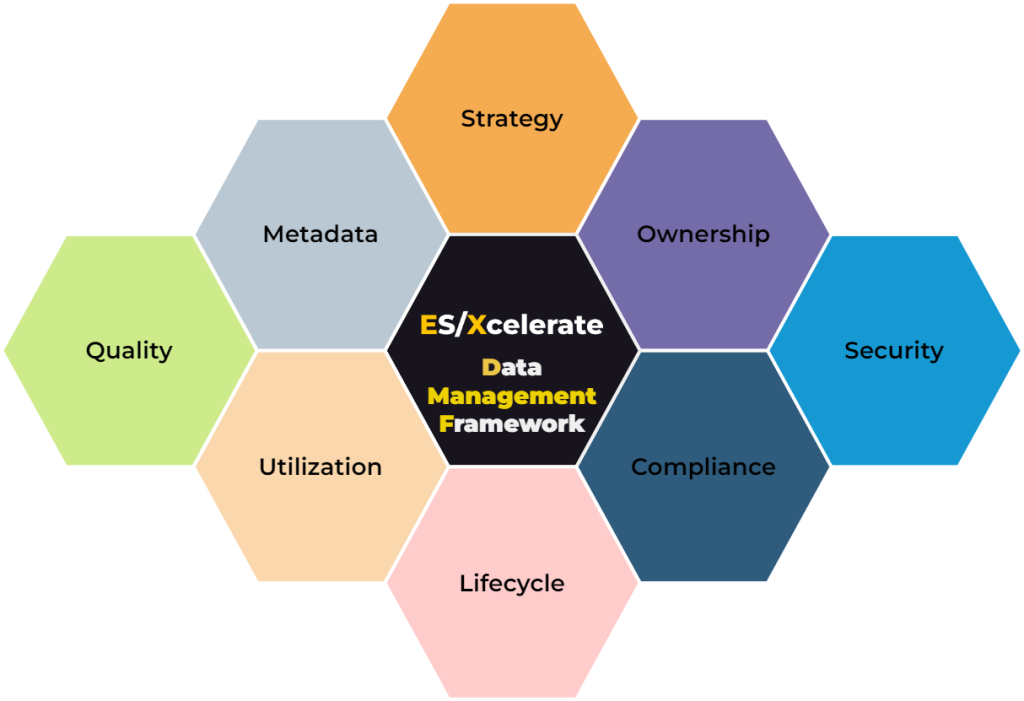Data is the lifeblood of any organization, and managing it effectively is crucial for achieving business goals and gaining competitive advantage. However, data management is not a simple task, as it involves various aspects such as data quality, security, lifecycle, metadata, utilization, and compliance. To address these challenges, organizations need a comprehensive and coherent architecture blueprint and framework that can guide them in designing and implementing data solutions.
The problem that ES/Xcelerate Data&AI aims to solve is how to measure and improve the maturity of data management across the organization, and how to align it with the business goals and data-driven excellence. The framework provides a set of criteria, indicators, and assessment methods to evaluate the current state of data management, identify the gaps and risks, and recommend the best practices and actions to achieve the desired state.
The scope of the framework covers the entire data ecosystem, from the data sources and platforms, to the data processes and pipelines, to the data products and services, and to the data consumers and stakeholders. The framework is applicable to any type of data, such as structured, unstructured, or semi-structured, and any domain, such as finance, healthcare, retail, or manufacturing.

© Nilay Parikh. All rights reserved. No warranty or liability implied.
The framework is designed to be flexible and adaptable, allowing the users to customize it according to their specific needs and contexts. The framework can be used to build mature and effective data solutions and designs, that can deliver value and insights to the organization, and that can foster trust and credibility among the data users and providers.
We will explore the ES/Xcelerate Data&AI Management Framework in more detail, and show how it can help you achieve data excellence in your organization.
| Principle | Description |
| Strategy | A clear and coherent vision of how data will be used to achieve the organizational goals and objectives, aligned with the business strategy and stakeholder needs. |
| Ownership | A well-defined and communicated assignment of roles and responsibilities for data creation, maintenance, access, and usage, ensuring accountability and transparency. |
| Quality | A continuous process of ensuring that data is accurate, complete, consistent, relevant, and timely, and meets the standards and expectations of the data consumers. |
| Security | A comprehensive set of policies, procedures, and technologies to protect data from unauthorized access, modification, disclosure, or loss, and to comply with the legal and ethical obligations. |
| Lifecycle | A systematic management of data from its creation to its disposal, including data collection, integration, storage, backup, archiving, retention, and deletion. |
| Metadata | A descriptive and contextual information about the data, such as its definition, structure, source, lineage, quality, and usage, that enables data discovery, understanding, and governance. |
| Utilization | A maximization of the value and benefits of data for the organization, by enabling data sharing, collaboration, analysis, and innovation, and by measuring and reporting the data outcomes and impacts. |
| Compliance | A adherence to the internal and external rules and regulations that apply to the data, such as data protection, privacy, security, and quality, and a demonstration of the data compliance status. |

Executive layer, providing succinct architectural insights through graphical representations and value-driven roadmaps. Align organizational data strategies with business goals, offering transparent views of budgetary, risk, and capability trade-offs.

Design layer for comprehensive architectural principles, design patterns, and technical recommendations. Tailored for architects and engineers, it guides through modern best practices, balancing quality, cost, and agility for robust implementations.

Data governance teams find their compass in the Controls layer, offering predefined audit controls, risk indicators, and capability maturity blueprints. Quantify operational metrics, ensuring a rigorous approach to quality, compliance, and usage across data processes.
License
This work (ES/Xcelerate Framework) by Nilay Parikh is licensed under CC BY 4.0 or view a human-readable summary.
If the above licenses do not suit your needs, please contact us at [email protected] to discuss your terms. We also offer more flexible commercial license that do not require attribution. The different licensing approaches reflect the intellectual property and commercial considerations associated with various framework elements while still promoting access.
Disclaimer
The views expressed on this site are personal opinions only and have no affiliation. See full disclaimer, terms & conditions, and privacy policy. No obligations assumed.
